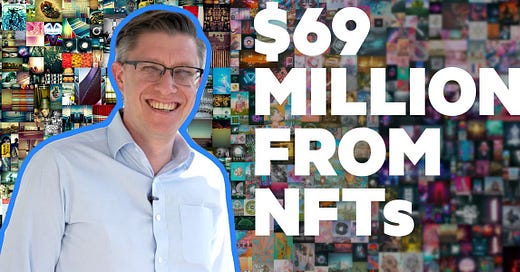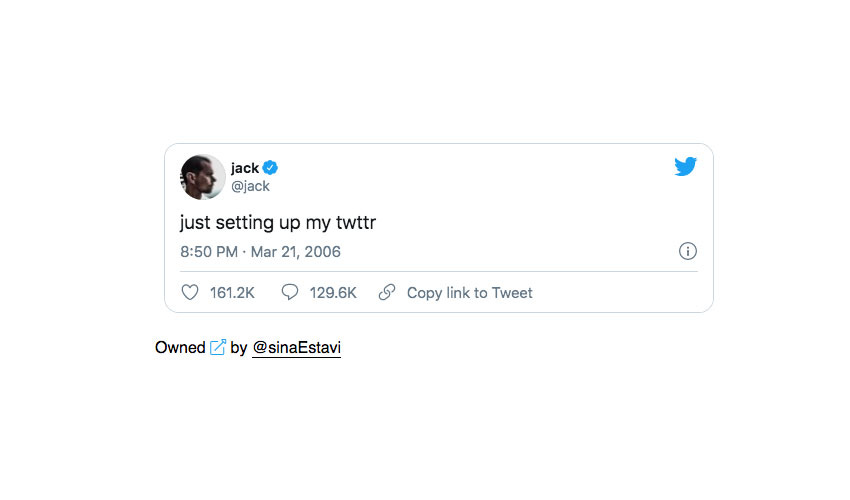On the 22nd of March this year, Twitter CEO, Jack Dorsey sold the first tweet on Twitter as NFT, it was sold at a price of $2.9 million and it’s not only tweets that are sold as NFTs; you can sell Arts, paintings, music, videos, JPEGs, GIFs and more.
Also in March, a single JPEG sold for $69 million, the NBA is also selling little moment of Basketball games for hundreds of thousands of dollars, this is all sort of digital things that people are purchasing a version of them for lots of money.
So you might be thinking why, or how does this add any value?
Well it’s special, it has something called an NFT, a fancy digital token that says this is the original of my digital art, the image can be replicated but the token can’t, the original can now be bought and sold and more importantly collected like fine art, only one person can own it. This technology is so great that we are now going to start seeing artists create art digitally, selling it virtually without the help of any middleman.
To understand how NFTs work, we need to understand what “fungibility” is;
Fungibility refers to the ability of an asset to be exchanged or substituted with similar assets of the same value. A simple example of a fungible asset is currency; let’s say you have five 1 dollar bills in your wallet, you may not want to carry around so much change so you exchange them for a single 5 dollar bill, the value of your money is still 5 dollars, regardless of the fact it’s now in a different form.
Non-Fungible assets are the opposite, each one is unique and can’t be easily substituted for something similar. For example think of the Mona Lisa piece of art, painted by Leonardo da Vinci in 1503 and bought by King Francis I of France in 1797, Guinness World Records lists Mona Lisa as having the highest ever insurance value for a painting. On permanent display at the Louvre in Paris, the Mona Lisa was valued at US$100 million on December 14, 1962. Now taking inflation into account, the 1962 value would be around US$850 million in 2021. The Mona Lisa is an original piece of art, it can’t be swapped out with any other painting because the painting does not hold the same value. Unsurprisingly non-fungible things are way more valuable than fungible things.
Now let’s talk about the “T" in NFT, it stands for Token.
Generally, a Token is anything that can be traded or exchanged, it doesn’t need to be an actual money but there will be perceived value in it and so it can be traded. In terms of non-fungible tokens (NFTs), think of tokens as collectibles, they can be anything, from the physical world or the online world, tokens can be; paintings, ornaments, clothing, they can even be a website domain! Essentially, these collectibles are tokenized, meaning the process of converting something of value into a digital token that's usable on a blockchain application. On blockchain, tokens represent unique items and are not directly interchangeable with another token because each token will have its own value.
So what’s an NFT?
NFTs are cryptocurrencies unlike fungible cryptocurrencies like Bitcoin and Ethereum, they are completely unique, they exist as a string of numbers and letters stored on a blockchain ledger, this information can contain who owns the digital asset, who sold it and when it was sold. This information is also encrypted ensuring the NFTs authenticity and scarcity, in doing so they fix a difficult problem for digital creators on the internet, how to make your creation scarce and therefore more valuable, they also act as a digital certificate of authenticity.
To summarize it all we can now say NFTs are; Tokens that are non-fungible.
So how are NFTs traded or how do they work?
Good question! This is where Blockchain Technology comes in, by tokenizing an item and putting it on the blockchain for sale, it provides authenticity and trust, essentially weeding out any potential counterfeits. Also since every transaction is recorded on the blockchain, you can see the entire history of the collectible; where it was made, where it’s been traded and who has previously owned it, blockchain technology is so special that the image can be replicated the token can’t.
Most NFTs are stored on the Ethereum blockchain and they use the blockchain to digitally record transactions. Ethereum, like Bitcoin, Dogecoin and Cardano etc. is a cryptocurrency, but the blockchain usually accepts such non-fungible tokens (NFTs), which store additional information that enables them to function differently.
The market for NFT boomed in 2020 to a market cap of 338 million dollars from about 41 million dollars in 2018, the surface has only been scratched in terms of its potentials. Artists can now have a digital signature on their great work of art that they created, and authenticity too and that can only happen on the blockchain technology where the information is recorded. They are non-fungible and because of that, there are only one of these tokens that can exist, it can’t be traded for anything similar because there is nothing similar that exists, the results is scarcity and limitations which drives up some of the prices.
This is going to be big, it’s a story of human psychology and the way we value things is shifting because of technology, a technology that some people think may revolutionize our society, while at the same time accelerating the climate disaster.
VIDEO: A Trophy presented to Magnus Carlsen (world best chess player) as an NFT.
Until next time, Happy Learning.
Enjoy your weekend.
Faith.







You probably read my mind, I've been surfing the web for a good explanation about this NFT of a thing.
That's cool of you bro💛
Keep up the good works